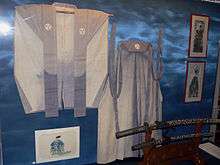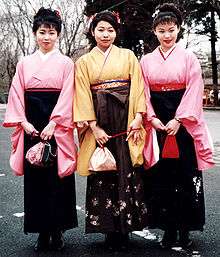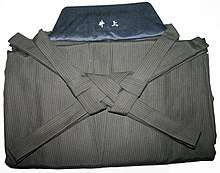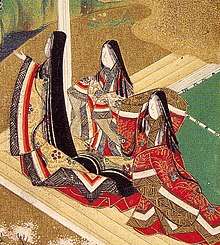Hakama
Hakama (Japanese: 袴) are a type of traditional Japanese clothing. Trousers were used by the Chinese imperial court in the Sui and Tang dynasties, and this style was adopted by the Japanese in the form of hakama beginning in the sixth century. Hakama are tied at the waist and fall approximately to the ankles. They are worn over a kimono (hakamashita).[1]
There are two types of hakama: divided 馬乗り (umanori, "horse-riding hakama") and undivided 行灯袴 (andon bakama, "lantern hakama"). The umanori type have divided legs, similar to trousers. Both these types appear similar. A "mountain" or "field" type of umanori hakama was traditionally worn by field or forest workers. They are looser in the waist and narrower in the leg.
Hakama are secured by four straps (himo): two longer himo attached on either side of the front of the garment, and two shorter himo attached on either side of the rear. The rear of the garment has a rigid trapezoidal section, called a 腰板 (koshi-ita). Below that on the inside is a 袴止め (hakama-dome) (a spoon-shaped component sometimes referred to as a hera) which is tucked into the obi or himo at the rear, and helps to keep the hakama in place.
Hakama have seven deep pleats, two on the back and five on the front. Although they appear balanced, the arrangement of the front pleats (three to the right, two to the left) is asymmetrical, and as such is an example of asymmetry in Japanese aesthetics.
Historically, a boy would start wearing his first pair of hakama from the age of 5-years-old, as commemorated in Shichi-Go-San; a similar practice as this, called breeching, was seen in Europe up-into the Victorian age, where boys would from then-on start to wear breeches instead of dresses, like a coming of age.
Men's hakama
The most formal type of men's hakama are made of stiff, striped silk, usually black and white, or black and navy blue. These are worn with black montsuki kimono (kimono with one, three, or five family crests on the back, chest, and shoulders), white tabi (divided-toe socks), white nagajuban (under-kimono) and various types of footwear. In cooler weather, a montsuki haori (long jacket) with a white haori-himo (haori-fastener) completes the outfit.
Hakama can be worn with any type of kimono except yukata (light cotton summer kimono generally worn for relaxing, for sleeping, or at festivals or summer outings). While striped hakama are usually worn with formal kimono, stripes in colours other than black, grey and white may be worn with less formal wear. Solid and graduated colours are also common.
While hakama used to be a required part of men's wear, nowadays typical Japanese men usually wear hakama only on extremely formal occasions and at tea ceremonies, weddings, and funerals. Hakama are also regularly worn by practitioners of a variety of martial arts, such as kendo, iaido, taidō, aikido, jōdō, ryū-te, and kyūdō. Sumo wrestlers, who do not wear hakama in the context of their sport, are, however, required to wear traditional Japanese dress whenever they appear in public. As hakama are one of the most important parts of traditional male formal dress, sumo wrestlers are often seen wearing hakama when attending appropriately formal functions.
In addition to martial artists, hakama are also part of the everyday wear of Shinto kannushi, priests who maintain and perform services at shrines.
Ōguchi-hakama, Uenobakama
Both are simultaneously worn with the courtly attire of sokutai (束帯). The ōguchi-hakama (大口袴) are red under-pants, with closed crotch, tied off on the wearer's left. The uenobakama (表袴), white and with an open fly, is then worn over the ōguchi-hakama, tied off on the right. These hakama designs can be traced to the Nara period.
Kamishimo: kataginu and naga-bakama

Hakama traditionally formed part of a complete outfit called a kamishimo (上下 or 裃). Worn by samurai and courtiers during the Edo period, the outfit included a formal kimono, hakama, and a sleeveless jacket with exaggerated shoulders called a kataginu.
Samurai visiting the shōgun and other high-ranking daimyō at court were sometimes required to wear very long hakama called naga-bakama (long hakama). These resemble normal hakama in every way except their remarkable length in both the back and front, forming a train one or two feet long and impeding the ability to walk normally, thus helping to prevent a surprise attack or assassination attempt.[2] Naga-bakama are now only worn particularly in noh plays (including kyōgen), kabuki plays and Shinto rituals.
Karusan-bakama
Some hakama during the Sengoku period had the hems made narrower than the body in imitation of the ballooning trousers worn by the Portuguese. This style carried on into the Edo period and became called karusan-bakama. In addition to the taper, they had a secured band of cloth—looking rather like a pants cuff—sewn around each leg’s hem, so the ballooning fabric would not open out like regular hakama. Also commonly known as tattsuke-hakama.
Sashinuki hakama
.jpg)
Sashinuki are a type of hakama that are meant to be worn blousing over the leg and exposing the foot. To accomplish this, they are somewhat longer than normal hakama, and a cord is run through the hem and drawn tight, creating a "ballooning" effect. To allow for the body required, more formal sashinuki were six-panel hakama rather than four panels. Technically, this cord around the ankle makes sashinuki a type of kukuri- (tied) hakama. The earliest form of sashinuki were cut like normal hakama (albeit a bit longer) and have a cord running through the hem of each leg. These cords were pulled tight and tied off at the ankle. This was the form commonly worn during the Heian period. Sashinuki were worn by court nobles with various types of leisure or semi-formal wear.
Yoroi hakama

Yoroi hakama (armored trousers) had small armor plates or mail armor sewn to the cloth of the hakama. They were worn by samurai warriors.
Women's hakama

Women's hakama differ from men's in a variety of ways, most notably fabric design and method of tying.
While men's hakama can be worn on both formal and informal occasions, women rarely wear hakama, except at graduation ceremonies and for traditional Japanese sports such as kyūdō, some branches of aikido and kendo.[3] Women do not wear hakama at tea ceremony. The image of women in kimono and hakama are culturally associated with school teachers. Just as university professors in Western countries don their academic caps and gowns when their students graduate, many female school teachers in Japan attend annual graduation ceremonies in traditional kimono with hakama.
The most iconic image of women in hakama is the miko or shrine maidens who assist in maintenance and ceremonies. A miko's uniform consists of a plain white kimono with a bright red hakama, sometimes a red naga-bakama during formal ceremonies.[4]
While formal men's hakama are made of striped fabric, women's formal hakama are either a solid color or dyed with graduating hues. Hakama for young women are sometimes sparsely decorated with embroidered flowers such as cherry blossoms. Women typically wear hakama just below the bust line, while men wear them at the waist.
Tying hakama
There are many ways for men to tie hakama. First, the obi is tied in a special knot (an "under-hakama knot") at the rear. Starting with the front, the ties are brought around the waist and crossed over the top of the knot of the obi. The ties are brought to the front and crossed below the waist, then tied at the back, under the knot of the obi. The hakama-dome is then tucked behind the obi, the koshi-ita is adjusted, and the rear ties brought to the front and tied in a variety of ways. The most formal method results in a knot that resembles two bow-ties in a cross shape.
The method of tying the ties is also different, with women's hakama being tied in a simpler knot or a bow. As with men's hakama, the front ties are first brought to the back, then to the front, then tied at the back in a knot. Then the back himo are brought around to the front. At this point, they may be tied with a bow at the left hip, just in front of the opening, with the ends of the ties at equal lengths. For more secure fastening, the ties may be wrapped once at center front, then tied inside at the back.
Folding hakama

Like all types of traditional Japanese clothing, it is important to fold and store hakama correctly to prevent damage and prolong the life of the garment, especially those made of silk. With hakama this is particularly important, since hakama have so many pleats which can easily lose their creases; re-creasing the pleats may require specialist attention in extreme cases.
Hakama are often considered particularly challenging to learn to fold properly, in part because of their pleats and in part because their long ties must be correctly smoothed and gathered before being tied in specific patterns.
Various martial arts traditions in which practitioners wear them have prescribed methods of folding the hakama. This is often considered an important part of etiquette.
In some martial arts it is also an old tradition that the highest ranking student has the responsibility to fold the teacher's hakama as a token of respect.[5][6]
References
- "The Politics of Dress in Asia and the Americas p.84".
- http://www.iz2.or.jp/english/fukusyoku/kosode/9.htm
- Noririn (2007-01-15). "Tooshiya". Casual Walk '07 photo album. Photozou. Retrieved 2008-04-20.
- Noririn (2007-02-03). "Imayou Hounou". Casual Walk '07 photo album. Photozou. Retrieved 2008-04-20.
- Yamanaka, Norio (1982). The Book of Kimono. Kodansha International, Ltd. pp. 35–39, 102, 103, 111–115. ISBN 978-0-87011-785-5.
- Dalby, Liza (1993). Kimono: Fashioning Culture. Random House. pp. 32–8, 55, 69, 80, 83, 90, 149, 190, 214–5, 254. ISBN 978-0-09-942899-2.
Further reading
| Wikimedia Commons has media related to Hakama. |
- How to fold the Hakama, Southern California Naginata Federation.
- How to tie a Hakama, Bu Jin Design Corporation.
- How to wash a Hakama, Kendo America. chinaman
